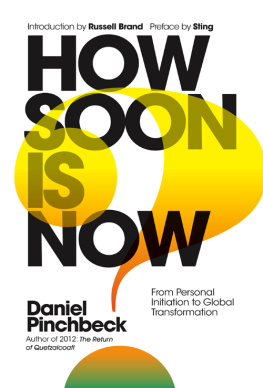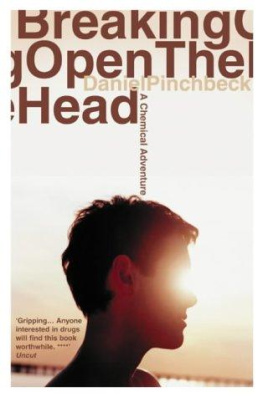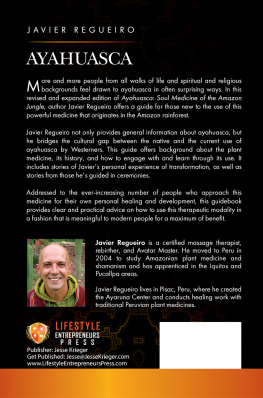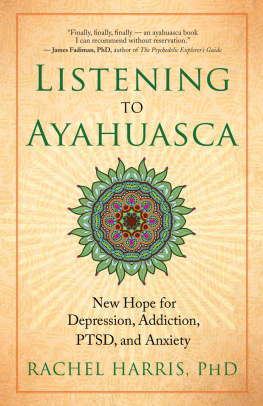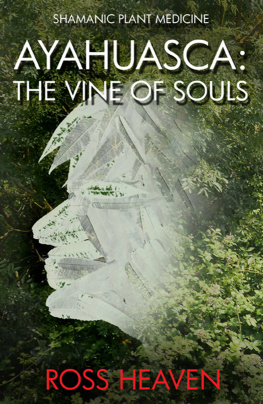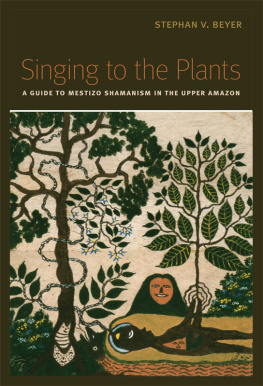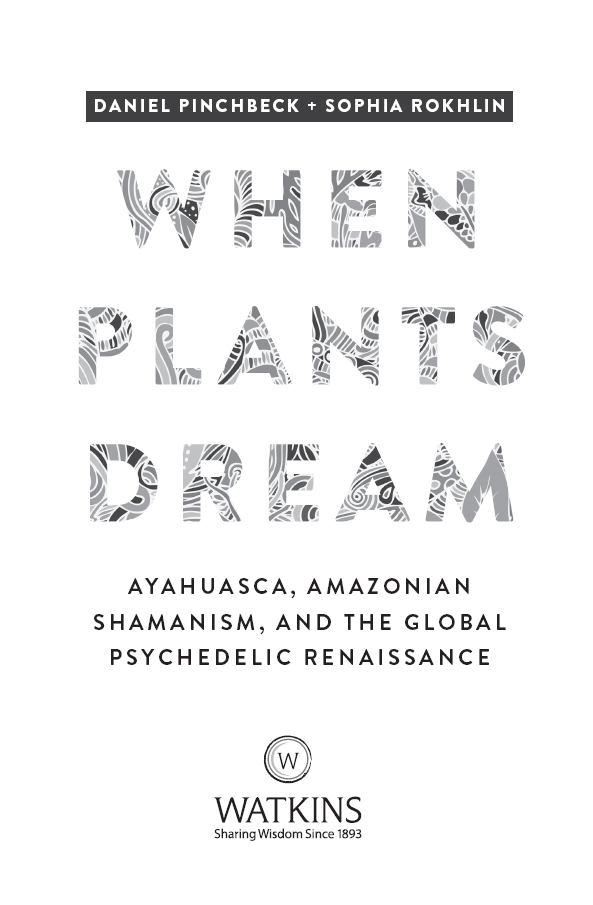Contents
Daniel Pinchbeck is the bestselling author of Breaking Open the Head, 2012: The Return of Quetzalcoatl and How Soon Is Now? He co-founded the web magazine Reality Sandwich and the online platform Evolver.net. His essays and articles have appeared in publications including The New York Times, Esquire, Rolling Stone, and ArtForum, and he has been a columnist for Dazed & Confused.
Sophia Rokhlin is an anthropologist and nonprofit organizer working with human and environmental rights organizations. She coordinates a permaculture program with the Chaikuni Institute and directs the regenerative ayahausca initiative at the Temple of the Way of Light in the Peruvian Amazon.
INTRODUCTION
Daniel:
I first took ayahuasca 20 years ago, in a high-rise apartment on the East River with two Californian neo-shamans a Caucasian couple in flowing robes who brought the brew from Hawaii. At the time, the vine of souls was hardly known in New York City. Michael Brownstein, an older poet friend of mine, first told me about it. He belonged to a small underground community of drinkers and got me an invite.
That initial journey was nauseating and not particularly revelatory. I had one experience of witness consciousness, watching the process of thoughts forming inside of my head like synaptic clouds. I saw a waterfall cascading in the jungle. I also experienced intense nausea and purged, uneventfully. Even so, I was intrigued enough to want to go deeper.
Inspired by Jonathan Otts Ayahuasca Analogues (1994), I started cooking ayahuasca in my apartment with friends. We bought the powdered plant matter from an online source, Basement Shaman. We drank it without ceremony, sprawled in my living room, listening to Beethoven, Bartok and Thelonious Monk as we journeyed through astral realms. These journeys left me yearning to explore traditional methods.
A year or two later, I went to the Amazon jungle in Ecuador to drink ayahuasca with an indigenous group, the Secoya, whose future was threatened by deforestation and the encroachment of the oil companies. The Secoya possessed what seemed to be an ancient tradition with the medicine, which had shaped their culture and spiritual worldview. There were an estimated 30,000 Secoya living between Peru and Ecuador at the beginning of the 20th century. By the time I visited them, their number had dwindled to fewer than 650, split between two distant villages.
Travelling to the Secoya homeland by plane, bus and boat, I was struck by the eerie correlation between our industrial civilizations rampant destruction of the rainforest and the power of this ancient visionary medicine that seems to be snaking out of the jungle to reach us in our metropolitan homes. As we pollute the Amazon, strip-mine, log and turn it into farms soybean and oil palm plantations that rapidly turn to dust bowls and scrubland we also heedlessly annihilate traditional cultures like the Secoya. When we drink ayahuasca, we find that these cultures hold precious even essential knowledge for our future.
In 2002 I published my first book, Breaking Open the Head, a personal and philosophical inquiry into psychedelic drugs and indigenous shamanic practices. In that work, I explored the gamut of visionary substances including natural plants like psilocybin mushrooms, peyote and iboga as well as synthetic compounds such as LSD, MDMA, ketamine and 2C-B. At the time the book came out, there was little mainstream interest in this field.
During the countercultural chaos of the late 1960s, governments made psychedelics illegal even though, just a few years earlier, leading psychologists were promoting the compounds as wonder drugs, the most powerful tools for exploring and understanding the human mind we had ever found. Over the next few decades, our societys gatekeepers demonized and repressed them to an extraordinary degree. Governments forbade scientists from experimenting with psychedelics on human subjects all over the world. Almost all reference to them was removed from psychology textbooks. In the 1990s in New York, where I lived, if you tried to speak seriously about the visionary states induced by these compounds, you would be ridiculed and dismissed.
As I researched Breaking Open the Head, I went through a series of astonishing initiations. I went to the equatorial jungles of Gabon in West Africa to take iboga a visionary plant sacrament that has become renowned for its ability to combat addiction in an initiation with the Bwiti community. For hours I lay on the ground of the Bwiti temple, travelling back through my life and replaying early childhood memories as well as scenes from my recent past, while the community played twangling harps and pounding drums around us. I visited the Mazatecs in Oaxaca, Mexico, where the magic mushrooms were rediscovered by Gordon and Valentina Wasson, an American banker and his wife, in the 1950s. I sat in ceremony with a descendant of the celebrated shaman Maria Sabina. I visited the legendary psychedelic chemist Sasha Shulgin and sampled some of his creations. Shulgin took the known psychedelic compounds and added molecules to them, transforming their effects.
Through these journeys, I realized psychedelics were not something useless and marginal, as my society believed. These compounds played a fundamental role in the religious and social life of indigenous cultures across the world. They could be transformative for modern people, such as myself, who had no sense of spiritual connection to the cosmos. This was an area with tremendous potential for humanitys future it was important news for our time.
Our society didnt outlaw and suppress psychedelics because they were particularly dangerous alcohol and cigarettes cause far more health problems and many deaths. Psychedelics were suppressed for ideological reasons. In the late 1960s, the establishment felt threatened by a mass opening of consciousness that was leading to movements for social and personal liberation. Journalists developed rhetorical tactics to denigrate psychedelics, lawmakers passed punitive laws to stop their use, and psychologists halted any exploration of this area. They upheld this moratorium for several decades.
It is astonishing that a society, like ours, founded on personal freedom, legally prohibits our innate dispensation to explore our own minds. Author Graham Hancock wrote in his 2009 article The War on Consciousness:
At the deepest level, our consciousness is what we are to the extent that if we are not sovereign over our own consciousness then we cannot in any meaningful sense be sovereign over anything else either. So it has to be highly significant that, far from encouraging freedom of consciousness, our societies in fact violently deny our right to sovereignty in this intensely personal area, and have effectively outlawed all states of consciousness other than those on a very narrowly defined and officially approved list.
Over the last century, mass consumerism became the way of life for most of the world. America and Europe launched this social experiment, which seeks to sugarcoat every aspect of life by providing a product for it. In a consumerist culture, everything is meant to be as safe and comfortable as possible. Unpleasant topics such as death should be kept hidden at all costs. The visionary plant sacraments used by indigenous cultures around the world do not conform to this ideology. Psychedelics like ayahuasca are ordeal medicines they taste terrible and induce nausea, often leading to intense vomiting or purging. In the process, they force you to confront your own soul. By doing so, they tend to reveal the path to a more authentic happiness.


